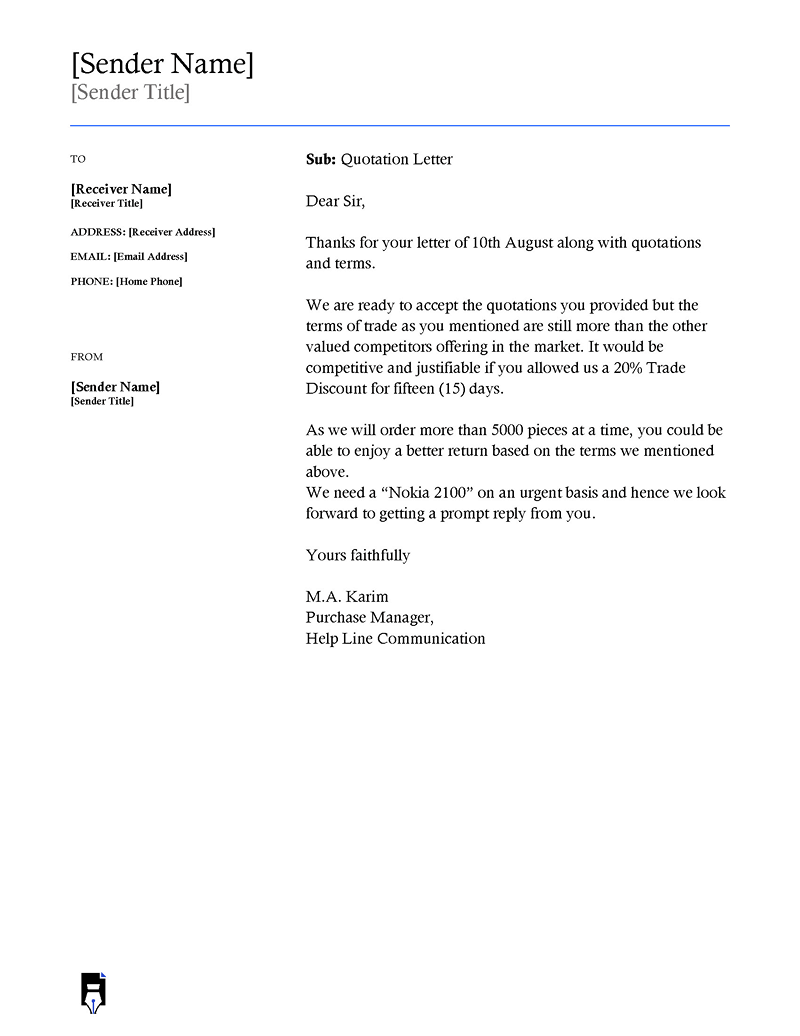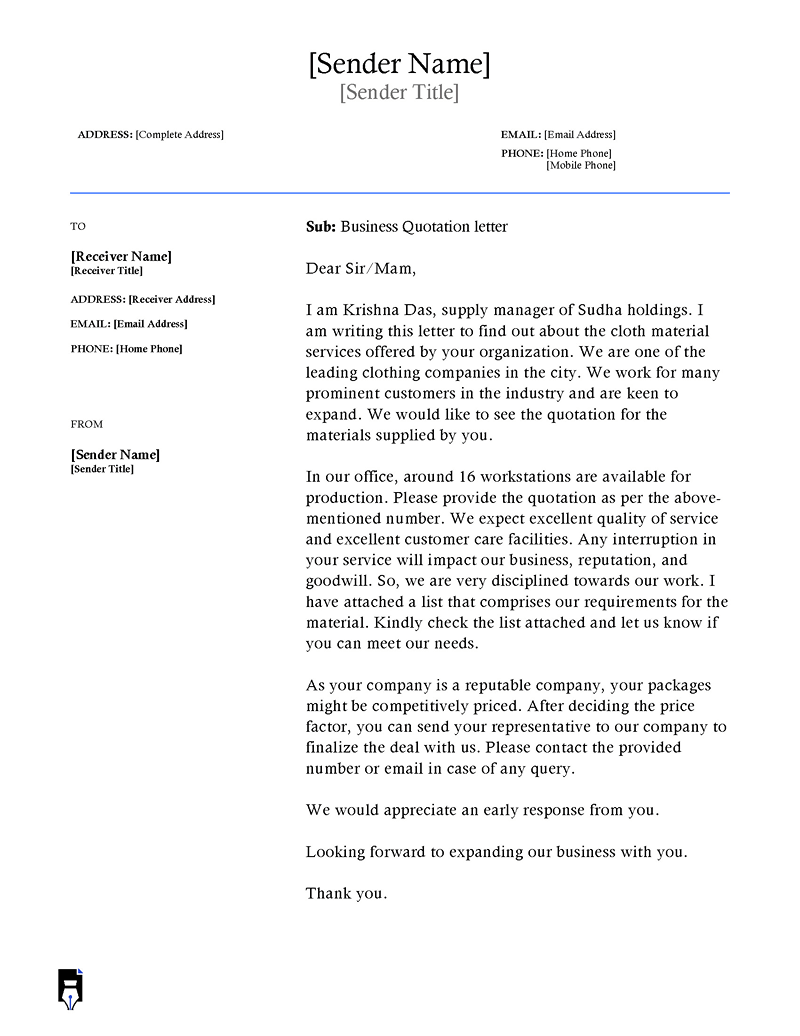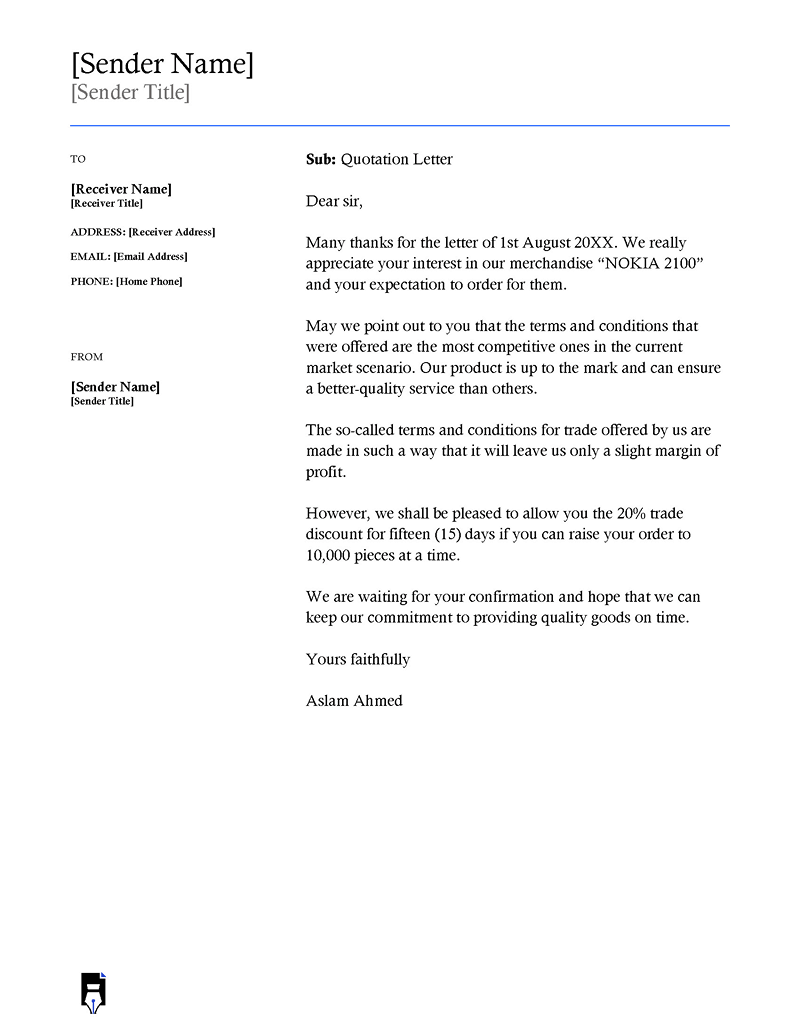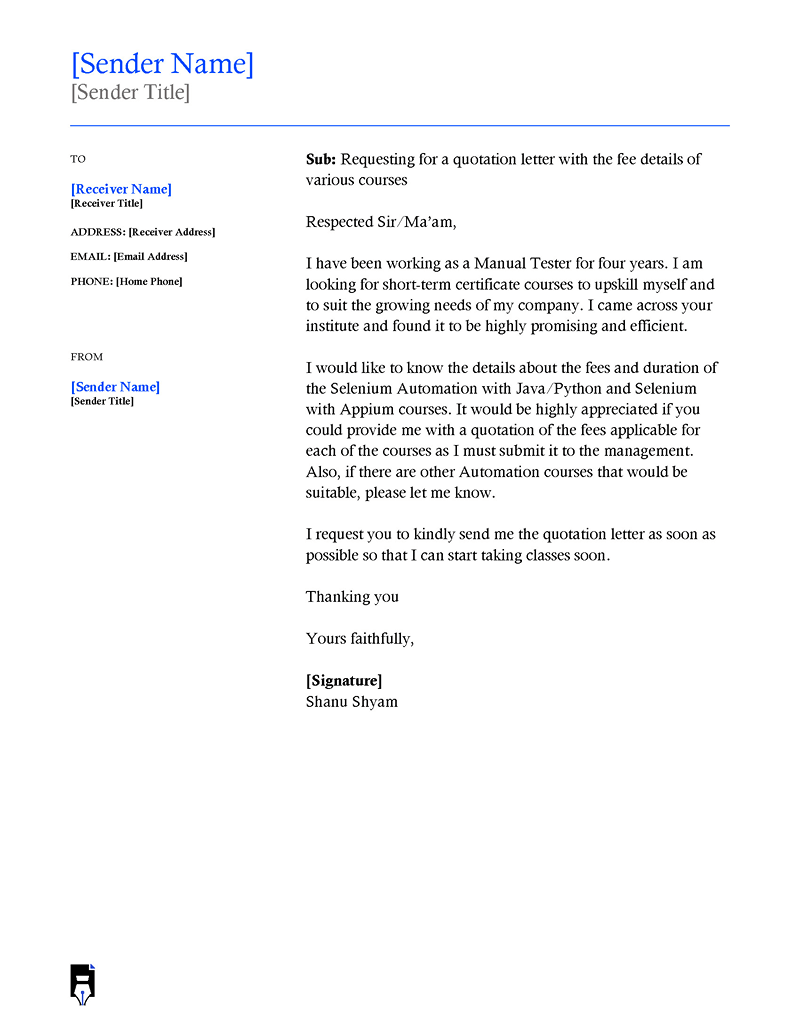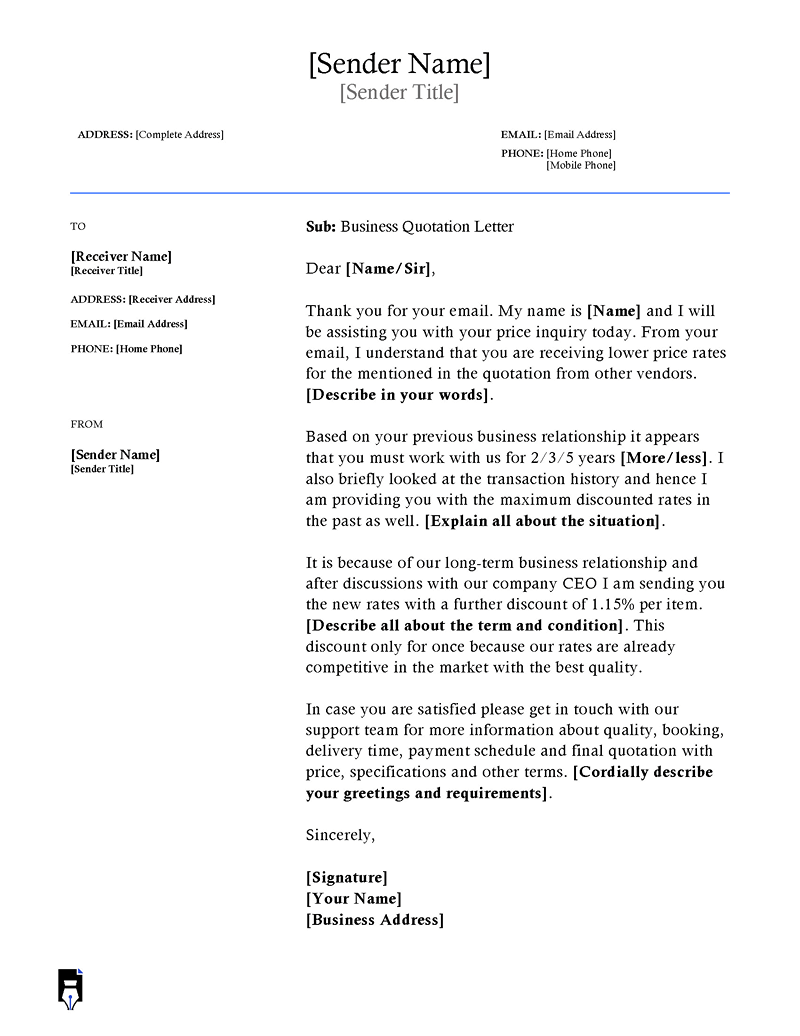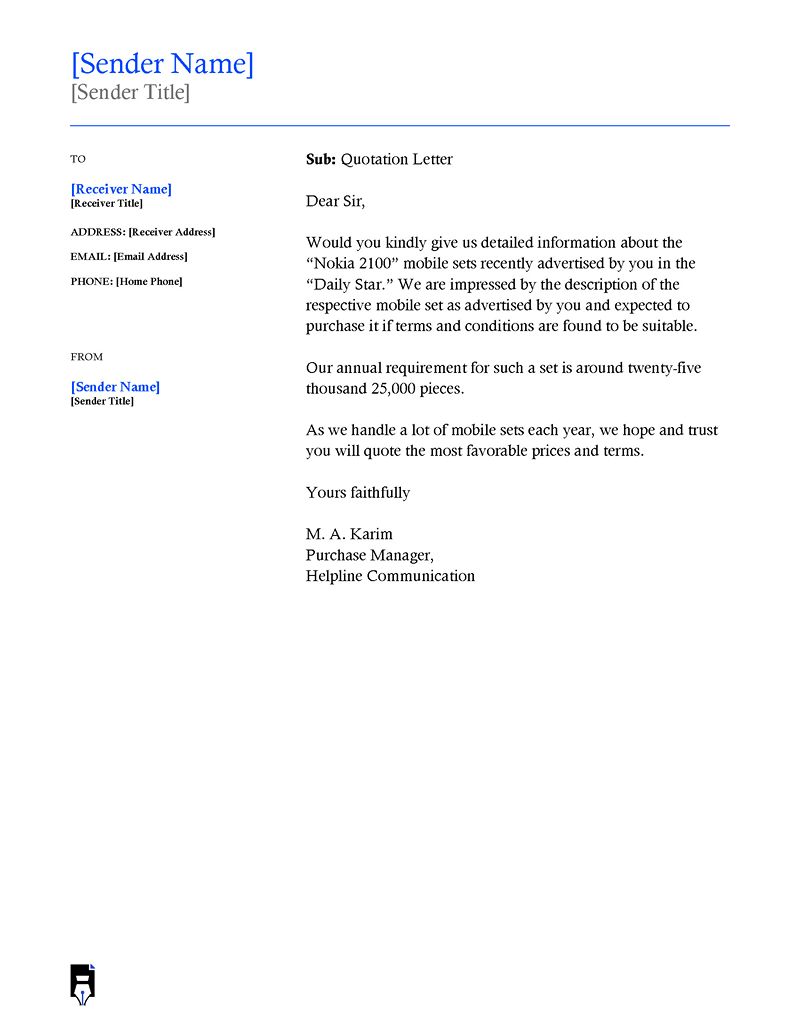A quotation letter is a document that provides a comprehensive cost of the goods or services an organization offers.
Details about the price, delivery timelines, and discounts are also included in the document. Businesses typically use it to provide prospective customers with an abstraction of the expenses associated with a particular product or service. The letter or email should give detailed information about the quoted products or services so the customer can make an informed purchase. It can also be used to promote any new products or services.
Quotation, proforma, and estimate are all terms that refer to documents that estimate the cost of goods or services. However, there are some critical differences between them:
- A quotation is usually sent in response to an inquiry and is typically valid for a specific period. Not every business can give quotations because it clearly defines time, raw materials, labor, and stable costs, which is impossible with a fixed price estimation.
- A proforma invoice is usually sent to a customer who has committed to purchase to finalize the sale details. It is used to secure a payment or deposit from the customer before delivery.
- An estimate, like a quotation, is sent to a customer who has inquired about a product or service. However, an estimate is issued when the seller cannot determine the exact price of a product or service in advance and is non-binding.
Free Templates
Given below are business quotation letter templates:
This article will guide a business owner in drafting a quotation letter or email upon a customer’s request. It will also discuss specific types of quotation letters, information to include, and considerations you should make when drafting it. The article will also provide quotation letter or email templates to ease the creation process.
Types of Quotation Letters or Emails
Different types of quotation letters serve different purposes. You should use the correct type of quotation in regard to your industry requirements.
The following are the various types of quotations:
Offer quotation letter/email
An organization uses this type of quotation letter or email to make an offer to sell a particular product or service at a specific price. It includes a detailed list of the goods or services the seller offers, the quantity of each item, the unit price, and the total cost. It may also include information about payment terms, delivery, and other relevant details.
Sales offer quotation letter/email
A sales offer quotation letter/email provides a concise summary of the costs and terms associated with a particular product or service so the prospective customer can decide whether to proceed with the purchase. It is usually valid for a specific period, after which the business may issue a new quote if the original quote is no longer accurate or if the customer wishes to change the order. It must include all the essential terms of the contract, such as the price, the goods or services the seller provides, and any conditions or warranties that apply.
Purchase order quotation letter/email
A buyer uses a purchase order quotation letter to request a quote from a supplier or vendor for a particular product or service. It includes a detailed list of the goods or services the buyer is seeking, the quantity of each item, and any relevant specifications or requirements. Once it is provided, the business can review the offer and decide whether to accept it. If the organization decides to proceed with the purchase, it may issue a purchase order to the supplier or vendor, specifying the terms and conditions of the transaction.
Business travel offer quotation letter/email
This quotation letter estimates the costs associated with a business trip. It may include information about airfare, hotel accommodations, ground transportation, and any other travel-related expenses. It may also include details about the payment terms, cancellation policies, and additional relevant information.
Corporate event offers quotation letter/email
This quotation letter/email approximates the costs associated with organizing a corporate event. It may contain information about venue rental, catering, entertainment, decorations, and other event-related expenses. It may also include details about the terms of payment, cancellation policies, and additional relevant information.
When to Send a Quotation Letter
A quotation letter is often sent at the request of a client who wishes to know more about a product or service before committing to a purchase. After receiving the request, sending a quotation letter as soon as possible is recommended. If you need more time to prepare an accurate quote, it’s appropriate to let the requester/customer know. You should also provide a timeline in the letter for when they can expect to receive the quotation.
Customers usually search for quotations from several businesses, so submitting a quotation letter promptly can help you stay ahead of your competition. However, ensure that the quotation letter is accurate and complete before sending it to avoid confusion. Assess the costs adequately and quote a price that shall not affect your bottom line.
How to Write a Quotation Letter: 7 Key Steps
When drafting a quotation letter, you must include specific elements to provide a clear and concise summary of the costs and terms associated with your particular product or service. A precise quotation helps potential customers make informed purchasing decisions.
The following is a step-by-step guide to assist you when writing a quotation letter:
Step 1: Specify the date of bidding
Include the date on which you submit the quotation to your potential client. This date should be at the top of the quotation letter and is used to establish the time frame in which the quotation is valid. The bidding date is vital because it helps your potential client or customer understand the timeframe they need to decide whether to accept the quote. It also lets you track the quotation’s status and follow up with the potential client or customer as required.
For example:
Date: 23 February, 2023
Step 2: Include a validity period
Specify a validity period during which your quotation remains valid, and you can accept it should the customer agree. This helps to set a deadline for the recipient to accept the offer and makes the quotation time-sensitive. Quotations are often based on current prices and market conditions. By including a validity period, you can ensure that the recipient knows that the prices quoted are only valid for a set amount of time and that they may change after that period. You may express the validity in terms of a date or with a statement.
For example:
Statement: This quotation is valid for 14 days, after which the availability of stock or prices may change without notice.
The validity period is crucial as it gives your potential client the timeframe for deciding whether to accept the quote.
Step 3: Add a bidding number
Assign a unique identifier to track and manage the quotation and differentiate it from other quotations that other businesses may submit for the same job. To add a bidding number to a quotation letter, you must follow the guidelines and procedures set forth by the organization requesting the quotations. You may be required to reference this bidding number, especially when submitting the quote through a specific bidding portal or platform. It may also be required when submitting the quotation letter or email along with a cover letter.
For example:
Bidding Number: #BID[Bidding Number]
Step 4: Specify the customer ID and address
Include the identification and contact information for the potential client receiving the quotation. A customer ID is necessary because it helps you keep track of the quotation and ensures that you send it to the correct customer. It also helps your customer identify and confirm that the quotation is intended for them. Include the customer ID in the header or footer of the letter.
For example:
Name:
[Customer Name]
Address:
[Physical Address]
Phone Number:
[Phone Number]
Email Address:
[Email Address]
Step 5: Describe the product or service
Outline the product or service you are offering so your potential client may understand if it will meet their needs. Include information about the quantity of the product or service you are offering and any warranties or guarantees present. You should provide a clear and detailed description of the product or service, including its features, benefits, and relevant technical specifications. You can give this information in a table for a better presentation.
For example:
Item:
[Name of Item]
Quantity:
[Quantity of Item]
Unit Price:
[Price per Item]
Total Price:
[Total Cost]
Step 6: Specify the terms and conditions
Specify the rules and regulations associated with the quotation. These terms and conditions outline the rights and responsibilities of both parties and any other vital details or considerations related to the sale. Some standard terms and conditions that you may include in a quotation letter include payment and delivery terms, warranties, guarantees, and return or cancellation policies.
For example, you may specify these terms and conditions in bullet form as shown below:
–Quoted prices include a 10% Value Added Tax (VAT) rate.
–Modes of payment are either cash or current cheque.
Step 7: Include your contact details
Include your contact information in the quotation letter. Contact information will make it easy for your customer to contact you should they have questions or need further clarification about the quotation.
For example, your contact information can be presented in the format shown below:
[Your Name]
[Title]
[Organization Name]
[Phone Number]
[Email Address]
Quotation Letter Sample
March 23, February 2023
#BID6528465
Natalie Voight
456 Cicero, Chicago, 50251
(123) 456-7890
Our quotation is valid for one week from the date of this letter.
Dear Ms. Voight,
Thank you for considering Auburn Stationers for your stationery needs. We are pleased to offer you the quotation below for stationery supplies.
Item – Quantity – Unit Price – Total
A4 Printing Paper – 1000 Reams – $5.75 – $5,750.00
Printing Toner – 20 Cartridges – $50.00 – $1,000.00
Spring File – 500 Pieces – $4.35 – $2,175.00
Total $8,925.00
Terms and Conditions
Payment should be made upon delivery by Visa, Mastercard or current check.
Delivery will be made within two days from the date of purchase.
All checks should be addressed to Auburn Stationers.
Do not hesitate to reach us if you have any questions or require additional information. We look forward to working with you.
Sincerely,
Brian Kellog
Sales Manager
Auburn Stationers
(987) 654-3210
Quotation Email Sample
Dear Brisbane Auto Garage,
Thank you for your inquiry and request for a quotation for fuel filters. I am pleased to provide the following quote:
Quantity: 250 Pieces
Unit Price: $35.50
Discount: 5% Off Orders above $1000
Total Price: $8,431.25
This quotation is valid for one month from the date of this email. Payment can be made by bank transfer. Delivery shall be made within a day from the date of purchase.
Contact me if you need more information or have any questions. I look forward to working with you.
Sincerely,
Victor Brown.
Best Practices to Consider
Now that you have acquired all the basic information for drafting a quotation letter, you need to present it professionally to increase your chances of securing the bid.
As discussed below, there are various considerations to make when drafting a quotation letter:
Double-check the client’s request
Double-check that the quotation is in line with the client’s request before sending it. Proofreading will help ensure that there are no errors or mistakes that could confuse the recipient.
Check the quotation
Make sure to outline the scope of work that the quote covers clearly. The scope includes any materials, services, or labor you will include in the quote.
Understand the client’s needs
Before drafting the quotation, it is essential to thoroughly understand your client’s needs and requirements as outlined in their request. By understanding the client’s needs, you will tailor the quote to their needs and avoid misunderstandings.
Use a template
Consider using a pre-made downloadable template to create a more efficient and accurate quote letter or email while projecting a professional image to potential clients. It allows you to rapidly and easily create a professional quotation letter without starting from scratch. A template can save you time, particularly if you are making multiple quotes for different clients.
Conclusion
A quotation letter is essential when presenting a potential client with a written estimate of the cost of a product or service. When drafting a quotation letter, it is necessary to understand the client’s needs and requirements thoroughly, outline the scope of work, use clear and concise language, include all relevant details, provide a timeline for delivery, and include any necessary terms and conditions.
Your organization must have a quotation letter format in place. The layouts are suitable for service or product quotations.
A critical element of any quotation letter is a display of thanks and openness to discuss the quote. It can help you acquire new business and establish a professional relationship with your clients.
